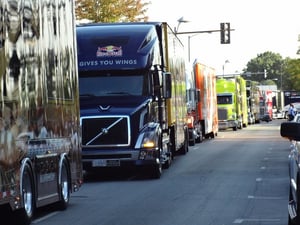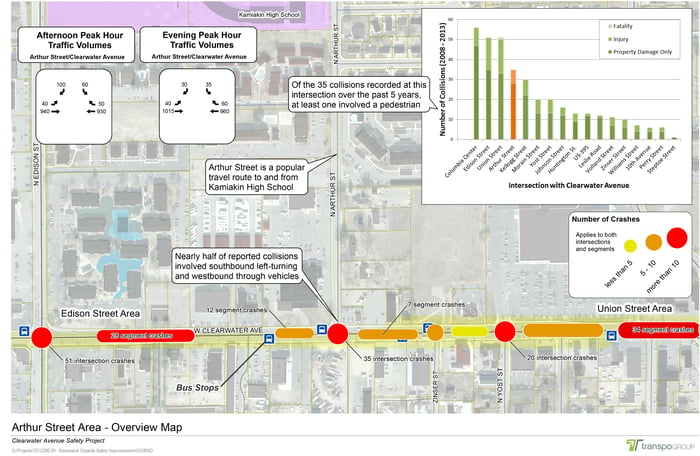 This post continues our series discussing the transformation of Main Street into a Complete Street in communities where Main Street serves as both a multi-modal local route and a state highway with high volumes of freight traffic. Our first post, The Evolution of Main Street, defined the problem and the second, Implementing a Complete Street Policy, looked at the role policy can play. In this post I am going to discuss how we can develop solutions by performing a corridor study.
This post continues our series discussing the transformation of Main Street into a Complete Street in communities where Main Street serves as both a multi-modal local route and a state highway with high volumes of freight traffic. Our first post, The Evolution of Main Street, defined the problem and the second, Implementing a Complete Street Policy, looked at the role policy can play. In this post I am going to discuss how we can develop solutions by performing a corridor study.
The Transportation Research Board (TRB) defines a corridor as an area where trips tend to cluster in a general linear pattern, with feeder routes linking truck lines that carry longer distance trips in a metropolitan area. A Main Street that also serves as a state highway is a textbook corridor.
As we’ve discussed all along, the problem with our hypothetical Main Street is that we need to accommodate high volumes of freight traffic within a Complete Street that provides safety and mobility to other users as well (pedestrian, bicycle, and transit). One of the best ways to explore solutions for this predicament is by performing a corridor study. The corridor study will help us determine the best way to serve existing and future travel demands, identify existing and future deficiencies, and evaluate alternative solutions.
It’s important to note that corridor studies are vast and not focused on one purpose or user. A corridor study is a way to address all your corridor problems. If you would like more information, I would recommend you check out TRB’s Guidebook for Transportation Corridor Studies: A Process for Effective Decision-Making.
Rather than talk about the process of performing a corridor study (which is very involved and can’t be boiled down enough to include in a single post), I want to focus on some of the likely alternatives that would be developed for our Main Street and how they may affect freight route efficiency:
Use Road Diet principles to minimize lanes and roadway width: This alternative would involve narrowing or removing existing lanes of travel to maximize efficiency. While this may seem counter-intuitive, a Road Diet allows a road to carry greater volumes of vehicles and is safer for bicycles, pedestrians and transit users. Providing improved flow of traffic along Main Street will benefit freight and the narrower lanes will increase awareness of speed and surroundings. The space opened up by the Road Diet can be used to accommodate bike lanes, wider sidewalk, transit or parking.
Intersections designed with users in mind: During the evaluation phase, a traffic analysis should be performed to determine where freight is going. A typical Main Street corridor will have numerous intersections, and knowing how each is being used by freight will affect your design. Intersections that need to accommodate freight turning movements require large curb radii and designated turn lanes. Intersections that are seldom used by freight can have smaller radii and curb bulb outs which will reduce pedestrian crossing time and improve traffic flow along Main Street.
Main Street couplet conversion: Perhaps a corridor study will find that not all of your Complete Streets needs can be met on just one street. A downtown couplet conversion will provide one way traffic operation on two parallel streets spreading user facilities between the two. This conversion will improve connectivity and make downtown easier to navigate whether driving, walking or biking. By spreading Main Street’s traffic over two streets, you can accommodate slower operating speeds, narrower streets, and shorter cycle lengths at traffic signals while reducing conflict points with pedestrians and providing faster travel times. This alternative has many benefits but can be difficult and costly to implement. Community involvement will be critical to the success.
Reroute to an alternate corridor (bypass): This solution can be a win-win for freight and the community. By providing a bypass route you will remove the freight user from Main Street and can focus Complete Streets design around fewer types of users. Trying to accommodate every type of user on every street can be difficult and the outcome can be less than ideal. As was discussed in the previous blog post on Complete Street Policies, every user should have a defined route through a community, but not all users need to follow the same path. A bypass allows city traffic to move more freely and safely, provides greater freight efficiency, and reduces urban noise. By shifting freight to a bypass we can separate the community center and highway functions of our Main Street.
 Image credit: Transpo Group
Image credit: Transpo Group
These alternatives only scratch the surface of what can be found through a corridor study. No two studies are the same and each study needs to be adapted to the conditions and issues that exist in your local area. If your community has a Complete Street project, is looking for ways to accommodate freight traffic or is considering the use of a Corridor Study, I’d love to have the opportunity to discuss it with you. You can reach me by leaving a comment below, or by emailing me at dteran@mackaysposito.com.
Stay tuned: in our next post we’ll talk about how to use Public Involvement with the Freight Community.
Check out our previous posts in this series:
The Evolution of Main Street (part 1)
Implementing a Complete Street Policy (part 2)
Truck image credit: Paul Sableman

